|
Have a safe day!
Friday, May 20
3:30 p.m.
DIRECTOR'S COFFEE BREAK - 2nd Flr X-Over
4 p.m.
Joint Experimental-Theoretical Physics Seminar - One West
Speaker: Karen Bland, Baylor University
Title: Lighting Up the Higgs Sector with Photons at CDF
8 p.m.
Fermilab Arts Series - Auditorium, Tickets: $7
Dr. Alexei Filippenko, University of California, Berkeley presents:
Dark Energy & The Runaway Universe
Monday, May 23
Particle Astrophysics Seminar - One West
Speaker: Smadar Naoz, Northwestern University
Title: Emerging from the Dark Ages
3:30 p.m.
DIRECTOR'S COFFEE BREAK - 2nd Flr X-Over
4 p.m.
All Experimenters' Meeting - Curia II
Special Topics: Feynman Computing Center Projects and Upgrades;
SRF Accelerator Test Facility at NML;
Other ARRA Projects at Fermilab
Click here for NALCAL,
a weekly calendar with links to additional information.
Upcoming conferences
|
|
Friday, May 20
- Chorizo burrito
- Smart Cuisine: Chunky vegetable soup w/orzo
- Buffalo chicken wings
- Cajun-breaded catfish
- Smart Cuisine: Teriyaki pork stir-fry
- Honey mustard ham & swiss panini
- Assorted sliced pizza
- Smart Cuisine: Carved turkey
Wilson Hall Cafe Menu
|
|
Friday, May 20
Lunch
- Melon & prosciutto
- Porcini-crusted filet mignon with fresh herb butter
- Glazed baby carrots
- Loaded mashed potatoes
- White chocolate-raspberry crème brulee
Wednesday, May 25
Lunch
- Chopped shrimp “waldorf” salad
- Strawberry cheesecake
Chez Leon Menu
Call x3524 to make your reservation. |
|
Museum outreach event to expose kids to science careers
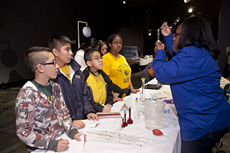 |
|
Children observe a scientist perform a demonstration at the Museum of Science and Industry's Fall Fling science outreach event in 2010. Photo credit: J.B. Spector, Museum of Science and Industry
|
A great way for children to learn about careers in science is to meet with the scientists themselves.
That’s what this Saturday’s Spring into Science event at the Museum of Science and Industry is all about. An estimated 1,000 kids and parents from more than 60 schools and community organizations across Chicago will have the opportunity to learn about science careers directly from the professionals themselves.
Fermilab will be among the more than 30 universities, industries, professional organizations and labs that will have representatives stationed at tables as the children, ages 8 through 18, pass through to meet them and learn about what they do.
“Our goal is to expose kids to a broad range of opportunities in science, technology and medicine, and give them a chance to talk to real people who work in those fields,” said Lizza Igoe, education coordinator at the museum and organizer of the event. “Every year, kids seem to walk away learning something they didn’t know.”
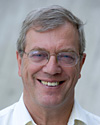 |
|
Mike Albrow
|
Particle physicist Mike Albrow and senior technician Linda Purcell-Taylor are looking forward to talking to the students about what they do at Fermilab.
“I would like the kids to get enthusiastic about science,” said Albrow, who has been involved in science outreach for elementary and high school students for many years. He is part of an initiative at Fermilab to talk to 10,000 kids in the classroom each year about science.
Although the responses range from excited enthusiasm to apparent boredom, Albrow believes it is worthwhile to keep trying to show them how fun science can be.
In order to explain what she does at Fermilab, Purcell-Taylor will bring along a motor controller and a sample profile monitor, which is used to show the position of the beam in a particle accelerator.
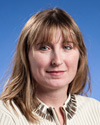 |
|
Linda Purcell-Taylor
|
Purcell-Taylor believes science outreach for children is important “because you’ve got to start from the ground up.”
“In order for our country to continue to make advances in science, we have to keep everybody involved, and that includes the kids,” she said.
Professionals from the Fermilab community who would like to volunteer at this event are invited to contact Lizza Igoe.
-- Christine Herman
|
In Memoriam: Lisa Rogers
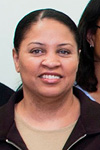 |
|
Lisa Rogers
|
Lisa Rogers, a Federal contracting officer in the DOE Fermi Site Office passed away on Thursday, May 9 , after battling cancer. She was 47.
Rogers began her career with DOE in 1980. In high school, she participated in a DOE program that offered students part-time secretarial work. After graduation, students could choose to work full time at DOE. Lisa did, starting out in the Financial Management Division of DOE’s Chicago Operations Office.
Throughout her career with DOE, Rogers served in numerous business management positions at the Chicago Operations Office. Prior to her most recent role in the Fermi Site Office, Rogers worked as a senior contract specialist on the DOE Chicago Management & Operating Contracts Policy Team. Rory Simpson, DOE Fermi Site Office business manager, recruited Rogers when a position opened up at the Fermi Site Office in 2009. Simpson, who knew Rogers since her arrival at DOE, worked with her many times during her career.
“Lisa was a good writer and a hard worker,” Simpson said. “She was dedicated and very knowledgeable in her field.”
In her role as a contracting officer and contract specialist on the DOE Fermi Site Office Business Team, Rogers was responsible for extending the DOE protective force contract, which allowed FRA/Fermilab more time to choose its own contractor. She recently worked on the FRA and DOE contract extension, which will extend the contract performance period for another five years. Rogers also oversaw procurement and property management functions at the laboratory.
Although Rogers was very private, she spoke frequently about her husband and three children, said Mark Bollinger, deputy manager for the DOE Fermi Site Office.
“She was the ultimate mom. She had three girls and they were everything to her,” Bollinger said. “Lisa was sweet and always had a smile for everyone.”
Simpson is happy that he had the chance to work with Rogers again.
“I’m glad she was here for the time she was,” Simpson said. “She was a part of our family and she will be sorely missed.”
View visitation and funeral information for Rogers online.
— Rhianna Wisniewski
|
Chu calls NSF's decision to abandon DUSEL 'disappointing'
From Science Insider, May 19, 2011
Energy Secretary Steven Chu says that he's "very disappointed" with the National Science Foundation (NSF) for pulling out of a planned $875-million underground science lab in South Dakota.
In his most extensive public comments since NSF's oversight body decided in December to walk away from the Deep Underground Science and Engineering Laboratory (DUSEL) project, Chu told a congressional spending panel yesterday that the decision was especially hard to fathom "since [NSF] started it."
NSF officials "had to make their own decision," Chu said in comments to reporters after the hearing. "But historically, they were the ones who said an underground lab would be a good thing and asked us if we'd like to come along. And we said, 'Sure, there are lots of interesting things that one could do there.' So it's always disappointing when someone says come join me and then, several years later, says that they aren't doing it anymore, or they may not be doing it."
Read more
|
|
SciBooNE and MiniBooNE inspect the neutrino pie
 |
|
A new analysis using combined MiniBooNE and SciBooNE data looked for disappearing muon neutrinos building on a MiniBooNE study from 2009.
Image credit: Chow.com |
When it comes to neutrinos, it's best to expect the unexpected.
Previous Results of the Week have showcased a surprising difference between MiniBooNE electron neutrino appearance and electron antineutrino appearance results. In this special result, we present an analysis done by combining MiniBooNE and SciBooNE data to improve our understanding of a MiniBooNE analysis from 2009.
Previously, MiniBooNE looked for an excess of electron neutrino events in a muon neutrino beam over a short distance (0.5 km). Experimenters then conducted the same search using antineutrinos. While the tests were the same, the results were surprisingly different. The neutrino data is consistent with background, but the antineutrino data shows an excess of events consistent with the controversial 1990 results from the Liquid Scintillator Neutrino Detector experiment at Los Alamos National Laboratory.
If this observed difference is due to new physics, the new physics must be rather exotic. The most common explanation for these results uses the idea of sterile neutrinos, which physicists believe are neutrinos that do not have charged partners. Collaborators believe that as the muon neutrino travels, it will sometimes convert into a sterile neutrino, which then would convert into an electron neutrino. We expect that the sterile neutrino is only detectable from this reaction.
Read more
-- Kendall Mahn and Yasuhiro Nakajima
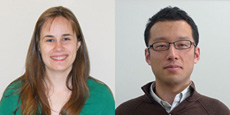 |
|
Kendall Mahn, TRIUMF; and Yasuhiro Nakajima, Kyoto University; were among the experimenters who performed this analysis.
|
|
Industrial area construction
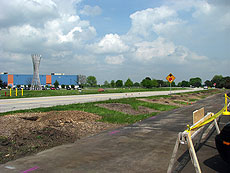 |
|
Construction and tree removal near the Industrial Building Complex and CDF are all taking place as part of an Industrial area upgrade.
|
|
Walking for wellness
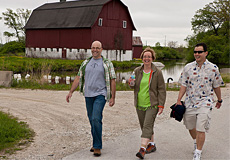 |
|
Elaine Phillips, PPD, walks with Jim Nipper and Cary Yoshikawa, Muons Inc. A record number of employees walked, ran, biked or rollerbladed around the Main Ring as part of yesterday’s Employee Health and Fitness Day. More than 330 people participated. Wednesday’s fitness event also kicked off Fermilab’s participation in the 10,000 steps program. Employees who walked can log their steps here.
|
|
Willard S. Boyle dies at 86; a father of the digital camera
From Chicago Tribune, May 19, 2011
Willard S. Boyle, who shared the 2009 Nobel Prize in physics for the invention of the revolutionary imaging device that is at the heart of digital cameras of all descriptions, died May 7 at a hospital in his home town of Wallace, Canada. He was 86 and had been suffering from kidney disease, friends said.
The digital imaging device, called the charge-coupled device, or CCD, allowed engineers for the first time to store a visual image in digital form, revolutionizing photography and a host of other fields. CCDs are at the heart of smartphones, camcorders, telescopes, supermarket bar-code scanners, fax machines and scanners, among other electronic devices.
Read more
|
|